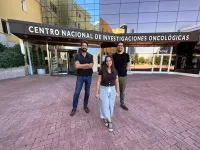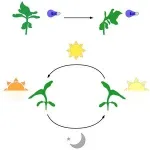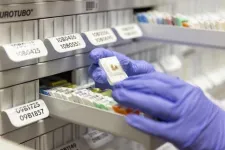(Press-News.org) In the late 1970s, the relationship between the c-Src gene and cancer was discovered. The first oncogene was identified.
Since then, c-Src has been found to be overactivated in half of colon, liver, lung, breast, prostate and pancreatic tumors, but its function is not yet fully understood.
CNIO researchers have now discovered that this oncogene is capable of 'self-activation', by means of a previously undescribed molecular mechanism. This finding has implications for the development of new drugs.
In recent decades, targeted therapy has been developed with the first drugs that act specifically against molecular targets (causes) of cancer, thus increasing their efficacy and reducing side effects. Many of these drugs inhibit the action of a type of enzymes called tyrosine kinases and have allowed a significant advance in the targeted treatment of several types of cancer.
Hence the relevance of the discovery made by researcher Iván Plaza-Menacho’s group, at the Spanish National Cancer Research Center (CNIO): a new activation mechanism for the first known tyrosine kinase, which is also the first oncogene.
“We have found a new paradigm in the mechanism of action of the first identified oncogene, c-Src, with important implications for the discovery of next-generation drugs,” explains Plaza-Menacho, head of the CNIO’s Kinases, Protein Phosphorylation and Cancer Group.
The study is published in Nature Communications.
An oncogene overactivated in the most prevalent tumors
Kinases chemically modify other proteins by adding the chemical phosphate group to them, and this modification (phosphorylation) acts as a chemical signal that activates cell proliferation. When kinases malfunction, cells constantly receive the order to proliferate, leading to tumor formation.
This relationship between cancer and c-Src was molecularly discovered in the late 1970s, but it is not yet fully understood, despite the long time passed, and it is still under research.
The c-Src oncogene appears overactivated in approximately 50% of colon, liver, lung, breast, prostate and pancreas tumors. What the new work reveals is a new, unexpected mechanism by which c-Src can autonomously activate itself through autophosphorylation (the process by which a protein phosphorylates itself) and cause cancer.
An autophosphorylating oncoprotein
To date, it was known that the function and activity of the c-Src oncogene are controlled by another protein kinase, CSK, which phosphorylates a key tyrosine in c-Src to inhibit its activity.
But CNIO researchers now show that c-Src, in addition, “has the ability to autonomously regulate the phosphorylation of this key tyrosine by phosphorylating itself,” says Iván Plaza.
The authors have managed to dissect at high resolution both the autophosphorylation sequence and the assembly process of the active molecule, which acts as a kinase, with the molecule that is phosphorylated, which acts as a substrate.
A therapeutic target in different types of cancer
There are inhibitors directed against c-Src activity with therapeutic applications. For example, dasatinib has been approved for the treatment of patients with multiple myeloid leukemia and acute lymphocytic leukemia. Clinical trials are currently ongoing in patients with metastatic breast cancer, colon cancer and prostate cancer with inhibitors targeting c-Src activity with other kinases, e.g. bosutinib, bafetinib or saracatinib.
The new results obtained by the CNIO group “have important implications in the design of and search for new generation drugs that block the allosteric and non-catalytic function of c-Src as a substrate in a more specific way,” says Iván Plaza-Menacho.
The researcher advances that “in the future we want to determine the three-dimensional structure of c-Src in its complete format, and to know how it is assembled and with which molecules it is capable of interacting and regulating at the cellular level when it is hyperphosphorylated in cancer”.
END
The first oncogene was found more than 40 years ago. CNIO researchers have just discovered that it has a previously unknown mechanism of action
2023-10-31
ELSE PRESS RELEASES FROM THIS DATE:
First classification of four stages of heart attack based on heart muscle damage is released
2023-10-31
Philadelphia, October 31, 2023 – Heart attacks, or acute myocardial infarction (MI), are one of the leading causes of death worldwide. The newly released Canadian Cardiovascular Society Classification of Acute Myocardial Infarction (CCS-AMI) appearing in the Canadian Journal of Cardiology, published by Elsevier, presents a four-stage classification of heart attack based on heart muscle damage. This work by a group of noted experts has the potential to stratify risk more accurately in heart attack patients and lays the groundwork for development of new, injury-stage-specific and tissue ...
New techniques efficiently accelerate sparse tensors for massive AI models
2023-10-31
Researchers from MIT and NVIDIA have developed two techniques that accelerate the processing of sparse tensors, a type of data structure that’s used for high-performance computing tasks. The complementary techniques could result in significant improvements to the performance and energy-efficiency of systems like the massive machine-learning models that drive generative artificial intelligence.
Tensors are data structures used by machine-learning models. Both of the new methods seek to efficiently exploit what’s ...
The world’s first collection of brain metastasis living samples will help treat each patient with the most effective therapy for them
2023-10-31
A paper published in Trends in Cancer explains the advantages of RENACER, the world’s first repository of live brain metastases samples, created by researchers at CNIO.
Live samples allow researchers to study the way cancer cells respond to drugs. This paves the way to create avatars for each individual patient to test out possible therapies before applying them.
RENACER is made up of around twenty hospitals, who attended their first general assembly meeting today at the Fundación Ramón Areces, the foundation that is funding the ...
Hey, Siri: Moderate AI voice speed encourages digital assistant use
2023-10-31
UNIVERSITY PARK, Pa. — Voice speed and interaction style may determine whether a user sees a digital assistant like Alexa or Siri as a helpful partner or something to control, according to a team led by Penn State researchers. The findings reveal insights into the parasocial, or one-sided, relationships that people can form with digital assistants, according to the researchers.
They reported their findings in the Journal of Business Research.
“We endow these digital assistants with personalities and human characteristics, and it impacts how we interact with the devices,” said Brett Christenson, assistant clinical professor of marketing at Penn State and first author ...
How cruise ships can steer clear of viral spread
2023-10-31
WASHINGTON, Oct. 31, 2023 – When COVID-19 began to spread across the globe, its effects were significantly pronounced on cruise ships. Indeed, compared to other population segments, cruise ship passengers became disproportionately infected and often, ironically, stranded on board to quarantine. That’s why focus has been directed at addressing the need for improved ventilation on cruise ships – since dispersing fresh air in cabins and other enclosed spaces is critical for mitigating viral spread.
In Physics of Fluids, by AIP Publishing, a group of researchers from Cyprus examined how ventilation can affect ...
Masks during pandemics caused by respiratory pathogens— evidence and implications for action
2023-10-31
About The Study: Robust available data support the use of face masks in community settings to reduce transmission of SARS-CoV-2 and should inform future responses to epidemics and pandemics caused by respiratory viruses.
Authors: Shama Cash-Goldwasser, M.D., M.P.H., of Resolve to Save Lives in New York, is the corresponding author.
To access the embargoed study: Visit our For The Media website at this link https://media.jamanetwork.com/
(doi:10.1001/jamanetworkopen.2023.39443)
Editor’s Note: Please see the article for additional information, including other authors, ...
Interpregnancy interval after clinical pregnancy loss and outcomes of the next frozen embryo transfer
2023-10-31
About The Study: The results of this study of 2,433 women who received in vitro fertilization treatment suggest that delaying frozen embryo transfer for at least six months after a preceding clinical pregnancy loss was associated with beneficial pregnancy outcomes. Further prospective studies are needed to confirm these findings.
Authors: Daimin Wei, M.D., Ph.D., of Shandong University in Jinan, China, is the corresponding author.
To access the embargoed study: Visit our For The Media website at this link https://media.jamanetwork.com/
(doi:10.1001/jamanetworkopen.2023.40709)
Editor’s Note: Please see the article for additional information, ...
Wearing your heart (monitor) on your sleeve
2023-10-31
WASHINGTON, Oct. 31, 2023 – Nearly 200 million people around the globe have coronary heart disease, which accounts for about one in every six deaths, according to the British Heart Foundation. That’s why the recent and rapid rise in wearable electronic health-monitoring devices with heart rate-measuring electrocardiograms (ECG) represents a significant step forward. By detecting cardiovascular ailments and helping assess overall cardiac health, wearable ECGs save lives, not to mention exorbitant ...
Studies illustrate moderate awareness—and room for growth—with new 988 lifeline
2023-10-31
Two studies led by researchers at NYU’s School of Global Public Health and Silver School of Social Work and published in JAMA Network Open show emerging awareness of the new 988 Suicide and Crisis Lifeline among both policymakers and the general public—but also point to potential areas of improvement for the vital nationwide service.
In July 2022, “988” became the new number for the National Suicide and Crisis Lifeline, which provides a phone, text, and chat resource for people who are experiencing suicidal thoughts, hopelessness, substance use crises, and other psychological distress. Similar to ...
High insulin levels directly linked to pancreatic cancer
2023-10-31
A new study from researchers at the University of British Columbia's Faculty of Medicine reveals a direct link between high insulin levels, common among patients with obesity and Type 2 diabetes, and pancreatic cancer.
The study, published in Cell Metabolism, provides the first detailed explanation of why people with obesity and Type 2 diabetes are at an increased risk of pancreatic cancer. The research demonstrates that excessive insulin levels overstimulate pancreatic acinar cells, which produce digestive juices. This overstimulation leads to inflammation that converts these cells into precancerous ...





